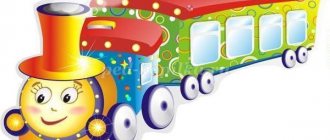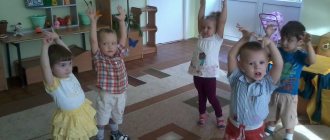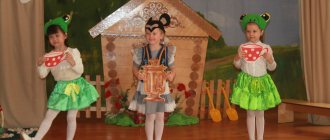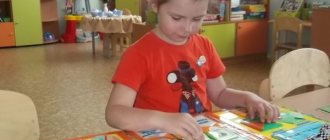Mission game in kindergarten
Play activity is an organized activity that involves directing the mental, physical and emotional efforts of children to achieve the assigned play task.
According to the Federal State Educational Standard (FSES), the goals of play activity in kindergarten are divided into educational areas of work with children:
- didactic - getting to know and expanding ideas about the world around, practicing skills and abilities determined by the requirements for the development of the sphere of cognition in preschoolers (through educational games, for example, children of the older group learn to “make friends” with letters, that is, to form syllables), development of work skills ( for example, in role-playing games, children of the first junior group help their mother with cleaning);
- developing - development of attention, speech, thinking processes, memory, formation of the ability to observe, conduct comparative analysis, compare, stimulation of imagination, creative vision, fantasy;
- educational - the formation of initiative, moral and strong-willed qualities, partnership, sociability;
- socio-communicative - familiarization with the observance of rules accepted in society, development of the ability to control one’s emotional manifestations, the ability to communicate with friends and adults.
In games, children learn to build partnerships with peers and adults
The educational objectives of games have their own characteristics depending on the age of the children and the type of game. According to the content of the game there are:
- didactic or educational, aimed at explaining, practicing or consolidating educational material;
- mobile, aimed at strengthening and preserving the health of children;
- theatrical, designed to reveal the creative potential of little pupils.
Table: tasks of different types of play activities in kindergarten
| First junior group (1.5–3 years) | Second junior group (3–4 years old) | Middle group (4–5 years old) | Senior group (5–6 years old) | Preparatory group (6–7 years old) |
| Didactic games | ||||
|
|
|
|
|
| Outdoor games | ||||
|
|
|
|
|
| Theatrical games | ||||
|
|
|
|
|
Video: formula for partnership in gaming activity
Stages of game development
D. B. Elkonin identified several types of games that gradually became more complex:
- Object-manipulative game. Here the child’s actions come down to imitation.
- Role-playing game. This type of game is aimed at mastering the norms of interpersonal relationships.
- A game with rules.
Finished works on a similar topic
- Coursework Game activities 410 rub.
- Abstract Game activity 250 rub.
- Test work Game activity 210 rub.
Receive completed work or specialist advice on your educational project Find out the cost
Let's also consider the classification of game methods according to N. Ya. Mikhailenko :
- Conditional objective actions.
- Behavior in the context of a particular role.
- Development of the plot.
Next, we will study the role of play in the development of a child’s psyche :
- Game as a way to study the characteristics of interpersonal interaction.
- Game as a way to study the peculiarities of the subordination of motives.
- Development of moral authorities.
- Formation of qualitatively new motives.
- Formation and development of new productive activities.
Let us also consider the features of play activities of preschoolers .
Older preschoolers are mainly attracted to role-playing games . The peculiarity of these games is that they can use some objects as substitutes for others, and also play various roles. It is especially common for preschoolers to imitate adults in their games. Thus, here we can talk about laying down a certain model of behavior.
Another important characteristic is that for children the process of the game than its result. Children play for the sake of the game itself, for the sake of the emotional reactions that he receives in it, and also for the sake of communication with other peers.
Too lazy to read?
Ask a question to the experts and get an answer within 15 minutes!
Ask a Question
Quite often, in their games, children demonstrate issues that have ever been raised by their parents. In addition, children have no problem replacing one item with a completely different one, giving it the same meaning and functions.
Children 5-6 years old are able to concentrate on a game plot for several hours and even days. Also, as they grow older, they give preference to certain game situations. While in younger preschool age everyday topics predominate, on average, production circumstances are of greater interest, and older preschoolers are captivated by socio-political scenarios, often intertwined with the plots of their favorite films or books. Rules for play activities of preschool children.
The development of play activity in preschoolers shows noticeable progress as children move from one age group to another. Kids are not able to plan the development of the plot, and more often repeat the same actions of adults.
Older children demonstrate creativity, and consider the relationships between players to be the most important in the game. Older children value the distribution of roles and adherence to the rules of the game.
Functions of gaming activities
The purpose of the game for a preschooler is an opportunity to unlock their potential, and for an adult it is to help guide the direction of the child’s development. This determines the functionality of gaming activities, divided into several types:
- entertainment function (stimulates the child’s interest, gives him pleasure from the process and result of the game);
- sociocultural (helps to comprehend the norms and rules of behavior in society);
- diagnostic (allows an adult to determine deviations in the development and behavior of a child, for example, the child’s isolation);
- correctional (aims to make positive changes in the child’s personality);
- therapeutic (helps in an entertaining way to overcome certain difficulties that the child encounters in various activities, for example, with the help of theatrical performances of therapeutic fairy tales, children overcome fears and become more sociable);
- communicative (forms the child’s ability to receive and transmit information in the process of communication, joint activities with peers, develops speech);
- cognitive and educational (helps to consolidate blocks of information received by the baby in the process of various types of activities, forms curiosity);
- function of self-realization (the game allows the child to determine the range of his interests, since the baby will not play if he is bored or uninterested).
This is interesting. To fully include all functions during the game, children must voluntarily take part in this type of activity. Only in this case will each child be able to learn moral and universal values and become an independent person in all types of social relations.
The game implements several functions for interacting with children
Classification of types of gaming activities
Types of play activities can be distributed according to the function of the adult and the form of initiative in children:
- creative games or play activities at the request of the children (kids choose the game themselves, designate the goal and come up with the rules, the adult is in the position of an observer);
- didactic, mobile and theatrical play activity or games initiated by the teacher (these methods of interaction are determined by the rules established by the adult);
- gaming activity determined by the traditions of the people (this type includes musical games, as well as historical games).
How gaming activities are integrated in the educational process
Based on the classification of games according to the form of participation of children and adults, we can come to the conclusion that the game is integrated into different areas of the educational process.
An example of integration would be the game “In the Hospital,” which I played with my students in the senior group. Before the introduction to the game situation, the children and I took a tour of the kindergarten’s medical office - that is, we implemented social and communicative tasks. We talked with a health worker about the purpose of a thermometer, scales, their importance in a person’s life - we accomplished the tasks of cognitive and speech development. We remembered the plot of K. Chukovsky’s fairy tale “Aibolit”, which helped to complete the tasks of the speech and social-communicative areas. And they also made attributes from plasticine (vitamins, tablets), thereby outlining the scope of artistic and aesthetic development.
The game is integrated into both direct educational and leisure activities of preschool children
Organization and management of gaming activities
The Federal State Educational Standard outlines the main components of the organization of the game. This is the totality:
- conditions of the organization;
- conditions for motivating children;
- conditions of implementation, including taking into account time for the implementation of the game plan.
Let's consider each of the components separately.
Conditions for organizing the game
- Voluntary participation of children in the game. The teacher does not impose, but involves them in the game, selecting techniques appropriate to the theme and type of game. For example, in order to involve 4-5 year old children in the didactic game “The Third Wheel” on the theme of vegetables, fruits, berries, the teacher introduces the children to a guest lesson - Dunno, who has a stomach ache because he, not knowing what is what, cooked soup not only from vegetables, but also from berries and fruits. Children, wanting to show their enlightenment and trying to help the character, are more actively involved in the game.
- A clear understanding of the essence and rules of the game, the role of each participant.
- The game should have meaning and contribute to enriching the social experience of children. Gaming activity involves solving a wide range of problems, so, for example, in an older group, children cannot fight with brooms while out for a walk - it is pointless. But the direct purpose of this attribute of work activity: cleaning areas of the territory according to commands for the “Our Cleanliness” prize - implements a whole set of educational tasks.
- Sufficiently equipped subject-development environment. The play area should have a variety of toys that will help kids realize their play plans. When developing a project for a play corner, the teacher needs to make sure that there are attributes that equally satisfy the interests of both boys and girls (dolls, cars). In addition, the playing environment should change and “grow” with the children: for example, pyramids in the younger group are replaced by wooden construction sets made of geometric shapes in the middle group. Many methodologists advise distinguishing between attributes for different types of games within the play area: fun for the intellect, equipment for outdoor and theatrical games. However, in conditions of limited group space, this is not so easy to do, so teachers get out of the situation by placing props in thematic corners: sports, theater and the actual play area.
For the organization of games, the equipment of the subject-developmental environment is essential.
Conditions of motivation
- Do not impose your vision of how to solve a game problem on your child. So, for example, if a child puts together a puzzle starting with the main figure of the plot, you should not insist that it is more convenient to lay out the details of the picture frame first.
- Praise kids for participating in the game.
- Starting from the middle group, all changes in the rules during the game should be agreed upon with the children at least at the level of agreement or disagreement, to do an additional task or to work out one or another plot twist. This condition applies mainly to games of an active nature and theatrical entertainment.
Terms of sale
- Creative approach of the teacher. An adult must necessarily work through the material based on the children’s requests. For example, when using a toy as a motivating device in class, it is better to take Luntik, familiar to all modern children, and leave Cheburashka until next time, after showing the kids a wonderful Soviet cartoon. This way, children will have an idea of the character, and the teacher will not need to explain to some children what kind of hero he is.
- A selection of games justified by the goals and objectives of a specific segment of the educational process. So, if at 3–4 years old children are introduced to several names of vegetables, fruits, and berries, then at the stage of introducing new material it is not worth giving the children the didactic domino “Gifts of Nature”, in which children need to collect cards depicting the stage of plant growth into a single chain , fruit, methods of its processing. But at the stage of consolidating the material, this game will be very appropriate.
- Focus on the individual characteristics of children. First of all, this concerns the organization of play activities with children with developmental disabilities, but we will dwell on this a little later. As well as the level of general development and temperament of the children. So, in the middle group, when organizing games to develop independence with children who often sort things out with their fists, the teacher should not completely withdraw into the position of an observer. It is better to accept the role of a player, observe the behavior of fighters, and redistribute playing roles if necessary.
- Accounting for the timing of the game. Failure to comply with this condition often fails young teachers who do not yet know how to correctly distribute time between stages of gaming activity. It is important to take time to explain the game, not to confuse the process itself, and be sure to summarize the results. Experienced teachers recommend adding +1.5 minutes to each game.
Children can get very carried away by playing, so the teacher needs to plan time for this type of activity with a reserve.
When are the games played?
Games are organized four times a day:
- after arriving at kindergarten before breakfast (from 5 to 40 minutes);
- after the first meal and before the start of classes (from 5 to 7 minutes);
- during a walk (an hour and a half);
- after sleep (20–40 minutes).
Games before breakfast
For the younger group, these are games that do not involve complex personal relationships, for example, with sand, water outdoors or with a construction set indoors. In the middle group, this could be playful interaction with toys brought from home. Children aged 4–5 years understand each other well, so the teacher does not interfere with the course of the game, but only corrects it. In the older group, games of all types are practiced. In this case, the selection should focus on the topic of the lesson that will follow breakfast. For example, before a lesson on speech development or literacy, you can play games to develop thinking and attention.
Games before classes
These types of play activities require little intellectual concentration (with a simple construction set, balls, small toys). Usually games with movements are selected that are not of a group nature, otherwise the kids will get tired. You should not offer children new games that require long explanations.
Before classes, it is recommended to conduct either individual games or in mini-groups
Games while walking
In the younger group, toys and sports equipment are used to expand children's motor experience. In the spring, these can be games with the ball “Catch the Ball”, running “Let’s Jump Like Grasshoppers”, jumping in the game “Catch Butterflies”, training in climbing and crawling, fun “Hide and Seek”, “Catch Up”, etc. In addition, kids are interested in participating in games with construction sets and sand, during which the teacher teaches children to play, inventing a game situation indirectly, for example, through a toy.
With children 4–5 years old, the teacher alternates games with and without rules, gaining experience in role-playing games (“Zoo”, “Family”, “Hospital”, etc.). In games, the teacher tries to rely on the children’s self-organization.
Older preschoolers can discuss what they will play before going outside. The teacher's participation consists of advice on ways to implement the game idea, as well as in choosing a driver (by counting or by direct assignment).
Play activities after sleep
Can be held outdoors (in good weather) or in a group. All interior elements are subject to play, and you can also introduce children to new play activities. Types of games can be combined in various ways. Games with natural materials are also included, which are inherently related to a program for familiarizing oneself with the world around and developing speech, for example, creating a forest clearing from dry leaves, chestnuts and acorns. After sleep, older preschool children can be captivated by long-term construction games, for example, the game “Building a House,” in which the building is repeatedly supplemented and modified over the course of several days.
This is interesting. Cleaning up toys at the end of the day can also be done in a playful way, in which "workers" from the construction site dismantle the toys, and "drivers" deliver them to shelves and cabinets.
It is important to teach children to put away toys after playing.
Report on the topic: “Game activity”
In order to achieve a game that is genuine, emotionally rich, including the intellectual solution of game problems, the teacher needs to comprehensively manage its formation, namely: purposefully enrich the child’s practical and gaming experience, gradually transferring it into a conventional game plan, and during independent games, encourage preschoolers to creatively reflect reality.
N. M. Askarina, summarizing pedagogical techniques for managing play in early childhood, for the first time clearly showed that for the emergence and development of play, it is necessary, firstly, to provide children with play material that actualizes their impressions of the environment, and secondly, to conduct training appropriate to the game .These provisions formed the basis of a comprehensive method of managing the game.
2. Features of play activities of children of primary, middle and senior preschool age.
Scientific analysis of play activity shows that play is a child’s reflection of the world of adults, a way of understanding the world around him.
In the child's first games, the leading role of adults is clearly evident. Adults “play with” the toy. By imitating them, the child begins to play independently. Then the initiative to organize the game passes to the child. But even at this stage, the leadership role of adults remains. As the child develops, the game changes. In the first two years of life, the child masters movements and actions with surrounding objects, which leads to the emergence of functional games. In functional play, unknown properties of objects and ways of operating with them are revealed to the child. So, having opened and closed the door with a key for the first time, the child begins to repeat this action many times, trying to turn the key at every opportunity. This real action is transferred to the game situation. Constructive games are more challenging. In them, the child creates something: builds a house, bakes pies. In constructive games, children understand the purpose of objects and their interaction. Functional and constructive games belong to the category of manipulative games, in which the child masters the surrounding objective world and recreates it in forms accessible to him. Relationships between people are conceptualized in story games.
The independent play activity of a child of the second and partly the third year of life takes place in the form of plot-based play. The child plays “mother-daughter”, “shop”, taking on a certain role. Plot-role-playing games appear at three to four years of age. Until this age, children play nearby, but not together.
The fourth year of life is a crucial period in the formation of play activity, a fundamentally new stage in its development in connection with the transition from plot-based play to plot-role play. Story-based role-playing games involve collective relationships. The psychological characteristics of games change: its content creates the basis for communication and joint actions of children. They become interested not only in the features and purpose of objects, the functions of the people around them, but also in their interactions and relationships. Of course, the inclusion of a child in group games depends on the conditions of upbringing. Children raised at home engage in group games with greater difficulty than children attending kindergarten. In collective story games, which become longer by the age of six or seven, children follow the intent of the game and the behavior of their comrades. Role-playing games teach children to live in a group. Gradually, rules are introduced into the games that impose restrictions on the behavior of the partner. Collective role-playing game expands the child’s social circle. He gets used to obeying the rules and requirements that are placed on him in the game: he is either the captain of a spaceship, or his passenger, or an enthusiastic spectator watching the flight. These games foster a sense of teamwork and responsibility, respect for fellow players, teach them to follow the rules and develop the ability to obey them. Using appropriate strategy and tactics in a story game with children of one age or another will allow them to develop appropriate gaming skills in a timely manner and will make the teacher a desirable partner in the game. In this capacity, he will be able to influence the theme of the game, the dysfunctional relationships between children, which are difficult to correct with direct pressure.
Techniques in gaming activities
When working on games, the teacher uses all methods of interaction with children, combining them depending on the type of game and the stage of mastering game actions. Thus, at the introductory stage of didactic games, explanation and demonstration will be predominant, and at the main stage of theatrical games, the emphasis will be on the practical activities of children.
Verbal techniques
Speech interaction in gaming activities is realized using:
- explanation, which can be presented in the form of a fairy tale plot (for example, the teacher can explain the conditions of the educational game “The letter is growing” with the help of a plot that the letter ate well and began to grow - children show how from a small letter in one corner of the sheet, it turns into a large one at the opposite end of the sheet);
- riddles and poems (usually this technique is used by the teacher to motivate children, so, before the theatrical game “Mirror”, I ask my senior group students the riddle “There is a Hanging Window. In the Window is Antoshka. Antoshka is gone - Empty Window”);
- reading, practiced in groups where there are children who can read (the essence of the technique is that children read the terms of the game themselves in the “magic instructions” or “letters” of fairy-tale characters).
Visual techniques
Visual images for children play a key role in all types of activities, since it is through the visual channel of perception that children learn about the world. Visibility in games can be represented by:
- pictures with illustrations of the progress of game actions (for example, for outdoor games);
- demonstration, that is, presentation of all actions by the teacher before independent repetition by the children (this technique is used in educational games - lotto, puzzles, etc. - and in moving ones, especially those where there are many types of movements replacing each other, and in theatrical ones, in which the teacher shows, for example, facial expressions and gestures of the character portrayed by the child);
- demonstration - the teacher shows an example of completing a task using a video (usually this technique is used in outdoor games, for example, with a ball).
If the game is well known to children, then a reminder of the conditions can be during the game activity
Attributes for games
Props for games deserve special attention, in particular toys, which in this type of activity can be of three types:
- ready-made (dolls, cars, animals, etc.) for getting acquainted with surrounding objects, developing imagination and the sensory sphere;
- semi-finished (cubes, pyramids, puzzles, etc.), designed to activate the child’s intellectual sphere through arranging the parts of the pyramid according to size, arranging objects using a construction set, etc.;
- materials for making toys (kinetic sand, clay, cardboard, etc.), the purpose of which is to stimulate creativity and imagination (modeling dishes from sand or clay, laying out cars with pebbles, etc.);
- theatrical and play attributes (flannelograph dolls, finger toys, costume elements, etc.), with the help of which children complement one or another chosen image.
Practical techniques
Through drawings, applications and crafts, children consolidate the information acquired during the game. For example, making a “Traffic Light” applique in the middle group may be an option for reinforcing knowledge of traffic signals from the outdoor game “Cars.”
A craft with traffic lights can be part of reinforcing the content of the game Cars
Diagnostics of gaming activity
Play is the main activity for preschoolers, so the dynamics of all areas of personality development can be traced based on monitoring play activity. The diagnostic monitoring card, which is carried out regardless of the age of the children twice a year (at the beginning and at the end of the school year), includes such indicators of play development as:
- content (sources of ideas and their diversity, number of game tasks, level of independence in solving game problems);
- types of interaction with materials for games (variety of plot, independence in actions with substitute objects and role-playing statements);
- the nature and time of interaction between children in the game (with whom the child enters into game interaction, who sets the game tasks, how long the interaction takes place).
You can view sample maps for game monitoring here. An analytical report is drawn up based on the map. An example of an analytical report on gaming activity can be seen in the publication of teacher Semeikina A.Yu.
Diagnostics allows us to track the development of play activity in children
Game activities in preschool educational institutions
Children spend most of their time in kindergartens, so play activities in preschool educational institutions play a large role in the development of personality.
In preschool institutions, games differ depending on age:
- 3 years - development of plot-display exercises. For example, putting a doll to sleep or repairing a car.
- 4 years - actions associated with imagination, increased communication with peers.
- 5 years old - the child is characterized by initiative. Preschool teachers create conditions for arranging the game with various attributes. For example, armbands with a red cross for nurses, weapons for soldiers.
During the day, a child can play 4 times:
- In the morning before breakfast.
- Between breakfast and classes.
- On the street.
- After a nap and afternoon snack.
Features of play activities in children with developmental disabilities
For special children, play is no less important than for healthy ones. However, it becomes a means of moral, mental and speech development only with the systematic and competent guidance of adults.
Play activities in children with hearing impairments
Main difficulties:
- children who are hard of hearing do not start the game themselves;
- mastering object-active substitution, that is, the meaning of a toy can be divorced from reality, for example, a wooden stick plays the role of a thermometer in the game “Hospital” and a pointer in the game “School” (the teacher pronounces any substitutions, but this is inaccessible to hearing-impaired children) ;
- mastering the meaning of words and phrases through the formation of subject correlation that arises in the process of playful communication (for example, during the game, children learn that Dunno’s jacket has a lightning bolt, but they cannot correlate this word with a natural phenomenon during a thunderstorm);
- mechanical repetition of familiar games, since children do not comprehend the semantic relationships in the plot (if a child is used to running in an outdoor game, then it is difficult for him to readjust and add walking in a different direction and pace).
Features of working with hearing impaired children:
- emphasis on role-playing games, where it is easier for children to comprehend both the principle of substitution and to expand their vocabulary through subject correlation (a white coat for both “Shop” and “Hospital”);
- expanding the list of games due to different ways of organizing play activity, for example, children present the same plot both on a flannelgraph and in the form of a dramatization, thereby kids see the variability of play actions in different circumstances;
- systematically pronouncing play actions for adults and children, adding new ones.
Play activities in children with visual impairments
The main problem of children with poor vision, as well as those with poor hearing, is that they themselves do not initiate the game. To explain how to play, healthy children need verbal explanation combined with clarity. The second component in working with children who have visual impairments loses its relevance. The word becomes the most important technique, thereby facilitating the merging of play with learning.
For visually impaired children, it is very important to develop fine motor skills in games so that children do not develop speech development delays
Play in children with mental retardation
The gaming activity of these children is determined by the severity of mental retardation. But in general, in the junior and middle groups, the emphasis is on story-based games in which children understand the variety of relationships: children-parents (“Daughters-Mothers”), patients-doctors (“In the Hospital”), etc. In the senior preschool children are attracted to object-based games: with natural materials, toys, which help children master the principle of substitution, which is important for play. The main task of the teacher is to help children form an imaginary situation, since sick children have a very poor imaginative sphere, and they themselves, without the guidance of a teacher, will not be able to do this.
Play activities in mentally retarded children
This type of activity is the main direction of correctional work with mentally retarded children. However, for children with intellectual disabilities, play is not a leading activity. Moreover, without the guidance of an adult, a sick child may not progress beyond simple manipulations with toys. The main task of the teacher is to form simple elements of a role-playing game by the end of preschool childhood (for example, play the role of a cashier in the game “Shop” or a guest in the game “We have guests”). At the same time, it is important to ensure that play manipulations are not repeated by the child many times, but varied, since for special children they do not carry a semantic load, that is, a boy rolling a car from corner to corner and imitating the sounds of a motor does not serve any purpose.
By the end of the preschool period, children with intellectual disabilities should move from simple manipulations with toys to elements of role-playing games
Play activities in kindergarten are an integral element of the content and organization of the educational process. On the one hand, the game is valuable in itself because, through it, children expand the sphere of knowledge, comprehend the norms and rules of behavior in society. On the other hand, the teacher uses the game as a structural basis for teaching and educational work, putting different types of activity and interaction options into its form. This determines the importance of a methodologically proven approach to choosing, preparing and conducting games with preschoolers.
The influence of modern conditions on children's play activities
Different types of children's games
Play activity plays a leading role in a child’s life. It is aimed at:
- Development of thinking, cognition, imagination.
- Formation of feelings and empathy. Modeling situations allows you to develop norms and rules of communication.
- Establishing contacts between peers.
- Formation of a child as a person.
The 21st century has changed the modern play activities of preschoolers. Many parents, in order to calm their child, give him a mobile gadget for watching various cartoons, so toys and dolls fade into the background.
Little children have phones and computers before they enter school, so the virtual world becomes the basis for personality development and limits the development of gaming activities. In such conditions, parents should carefully monitor daily traffic on the Internet and try to protect them from unwanted information.
Play is the main activity in childhood. It participates in the development of the child and helps in the formation of individual qualities, but requires the individual to have verbal communication skills and the ability to clearly express their thoughts.
“Eternal games” which were popular decades ago and have not lost their relevance for modern children. What are they? You will find out from the video.







